PR insights from Spain
Home to the world’s oldest restaurant, Madrid’s Casa Botín, the largest unfinished Catholic church - Barcelona’s La Sagrada Família has been under construction for 130+ years! - and La Torre de Hércules in Coruña - the only Roman lighthouse in the world that’s still functioning - Spain is a vibrant country with a fascinating history and rich cultural scene.
The same can be said about its lively media landscape, which has become particularly competitive in the digital arena. Here, our esteemed associate Kiko Sánchez Blanco shares his insights on the market as part of our Global PR series:
🇪🇸 The Spanish media industry has become increasingly polarised. There’s a growing perception by Spanish citizens that the media, especially those linked to large public and private corporations, are guided mainly by political interests and business clientele, and not by public service
🇪🇸 El País, El Mundo, ABC, El Economista and La Vanguardia lead the national and business titles, while El Confidencial or El Diario remain two of the most influential online dailies. Brands looking for extensive broadcast outreach should consider Onda Cero, Cadena Ser and Cope as key radio stations and RTVE, Tele5 or Antena3 as the main TV channels with the biggest audiences. However, TV viewership has reached a 30-year low with a greater number of Spaniards now accessing the internet than watching TV
🇪🇸 Competition in the online arena is rife. Against a backdrop of declining print circulation (60% of the newspaper industry’s readers has been lost in the past decade) and ad income, many national, business and even regional titles have sought new revenue streams by offering premium content through paid digital subscriptions
🇪🇸 More and more media outlets expect a combination of editorial and paid content. To gain traction, brands need to complement their earned media efforts with additional marketing investment and include some of the country’s top social media platforms, Tik Tok, YouTube, Instagram or Facebook in their campaigns
🇪🇸 Spain is home to the second most spoken language in the world, with 427 million native speakers in 20 countries, only exceeded by Mandarin Chinese. Given this global context, many Spanish media outlets design their products anticipating their potential extension beyond the borders of the country. Given 2024 is a year of major political and sporting events, it’s hoped bigger audiences will be achieved to help counter audience fragmentation and news avoidance
Keen to talk about how we can help you make an impact in Spain? Please get in touch!
